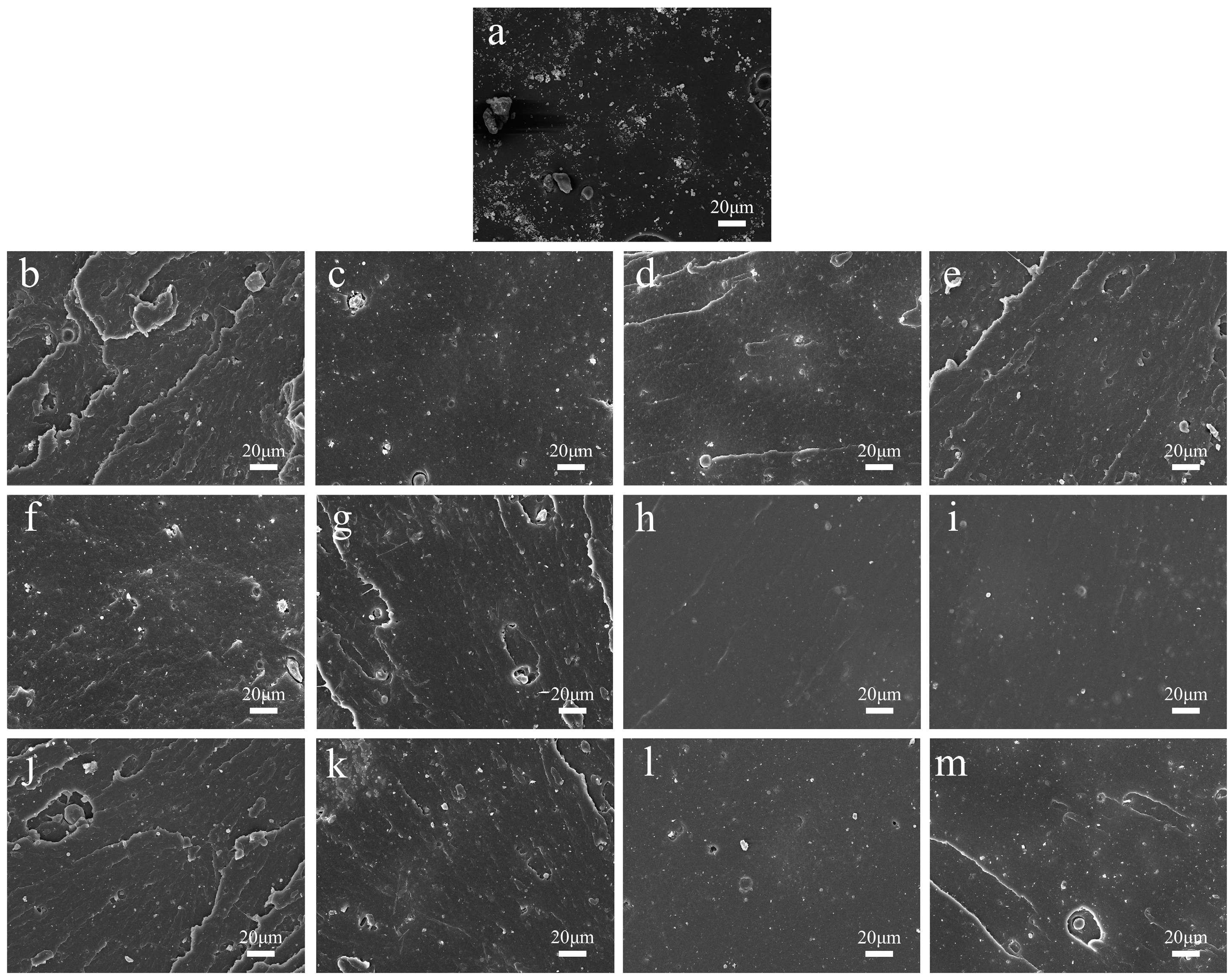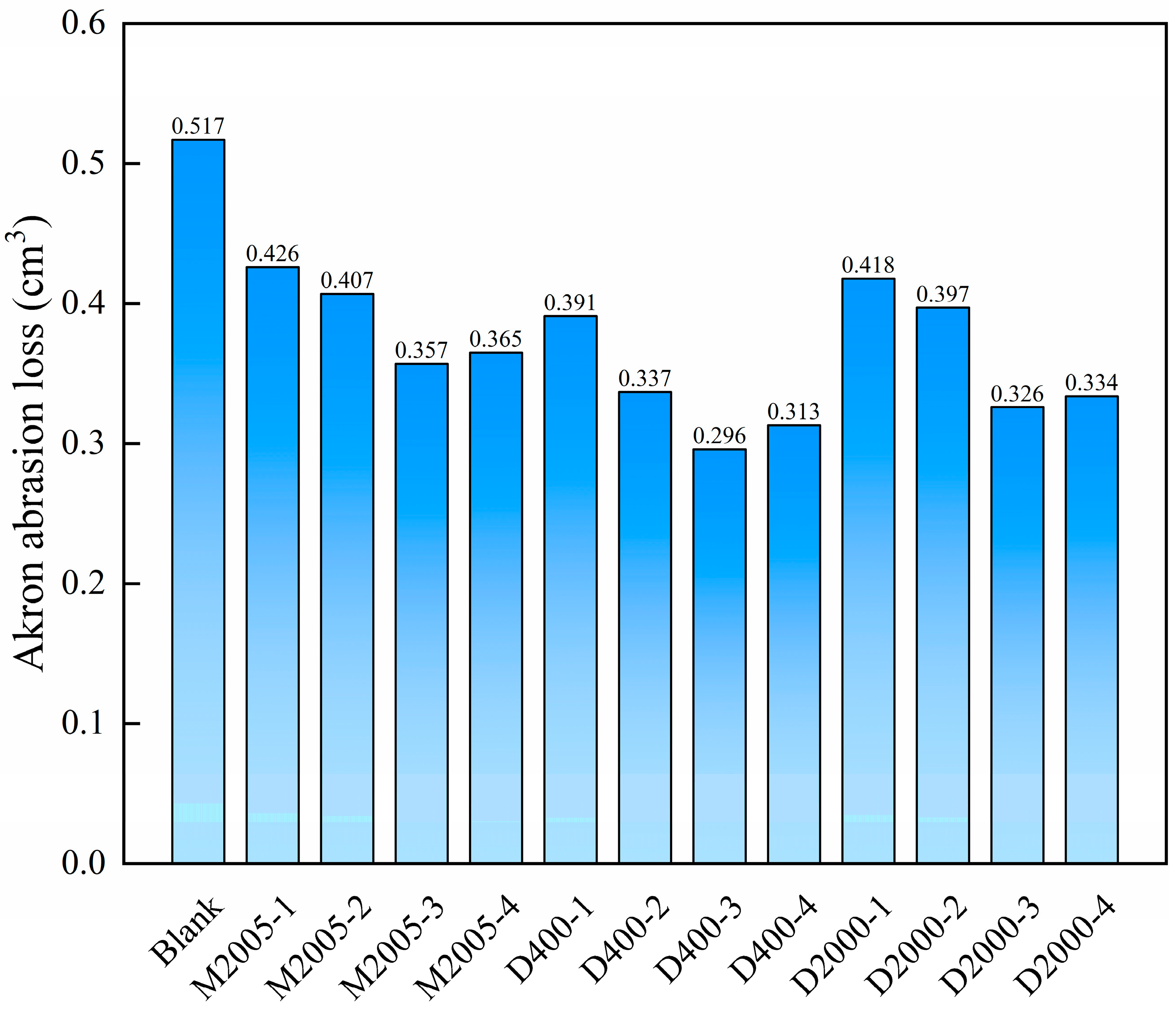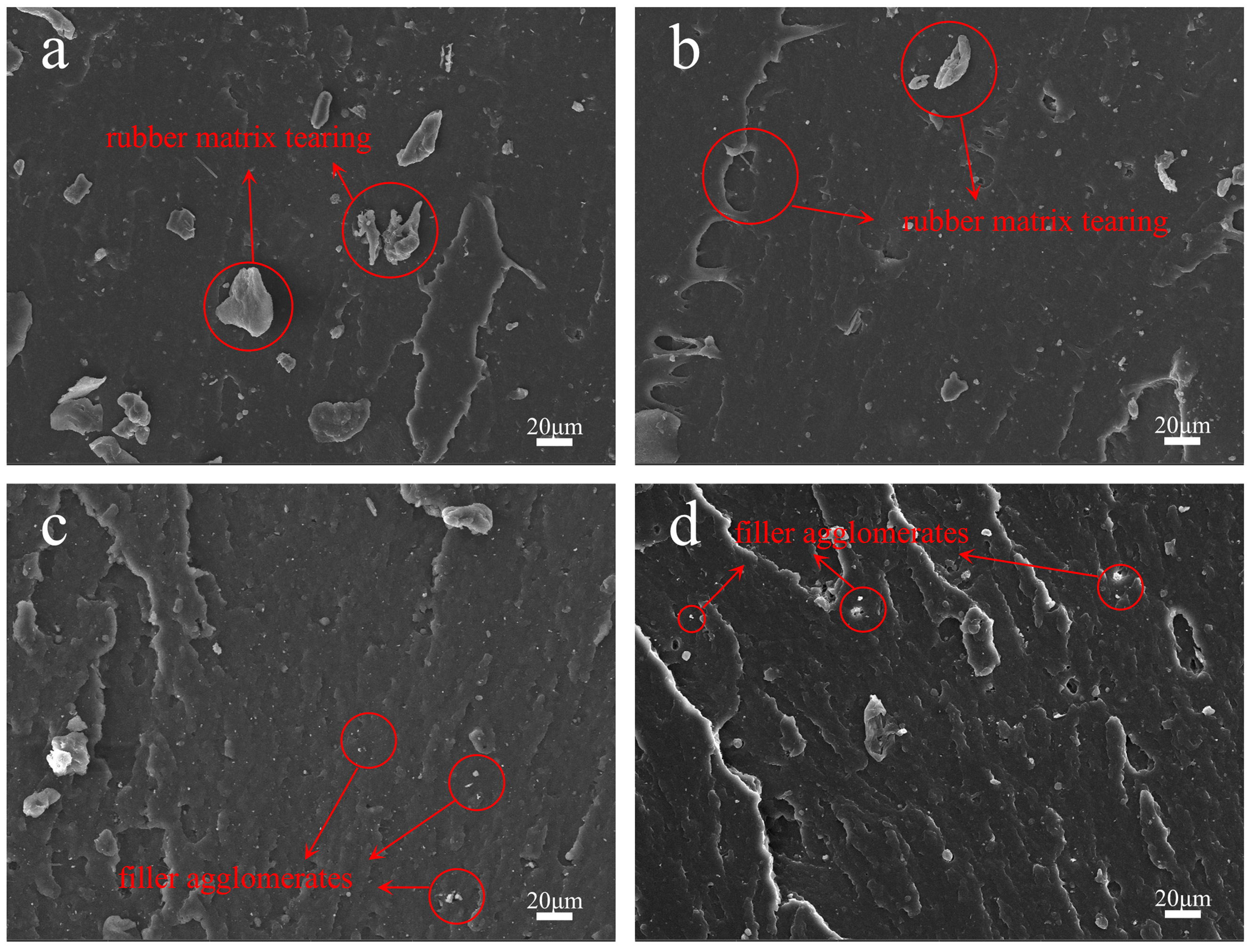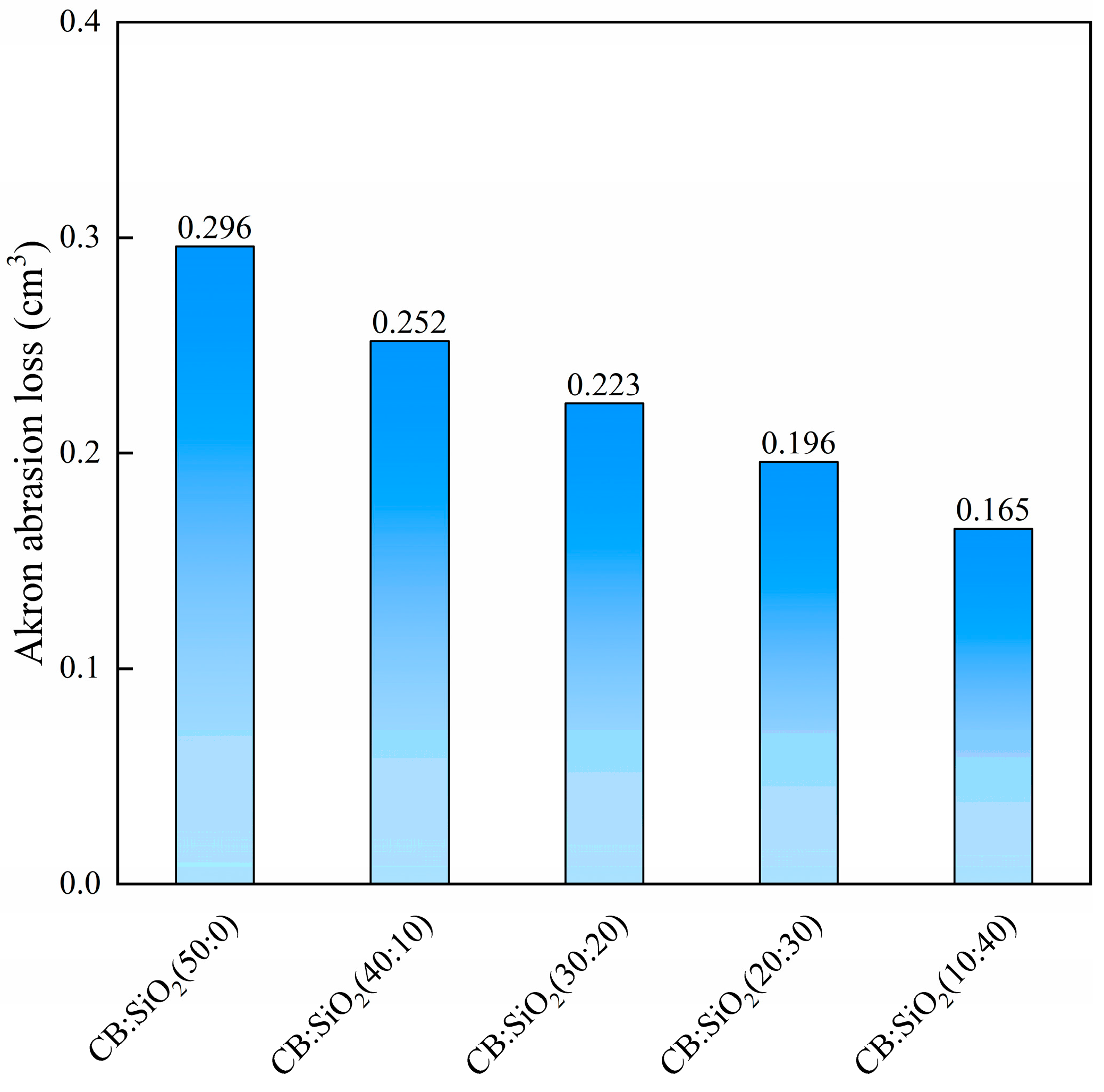Amino-Terminated Poly(propylene oxide) as an Interfacial Dispersant for Low-Conductivity Silica/Carbon Black Hybrid-Filled Natural Rubber Composites
Abstract
1. Introduction
2. Materials and Methods
2.1. Experimental Materials
2.2. Preparation of Natural Rubber Composites
2.3. Characterization
3. Results and Discussion
3.1. Effect of Amino-Terminated Poly(propylene oxide) on Carbon Black/Natural Rubber Composites
3.1.1. Influence of Amino-Terminated Poly(propylene oxide) on the Dispersion of Carbon Black in Natural Rubber
3.1.2. Influence of Amino-Terminated Poly(propylene oxide) on the Vulcanization of Carbon Black/Natural Rubber Composites
3.1.3. Effect of Amino-Terminated Poly(propylene oxide) on the Mechanical Properties of Carbon Black/Natural Rubber Composites
3.1.4. Effect of Amino-Terminated Poly(propylene oxide) on the Aging Resistance of Carbon Black/Natural Rubber Composites
3.2. Effect of Different Silica-to-Carbon Black Ratios on the Hybrid Filler/Natural Rubber Composites
3.2.1. Dispersion of Fillers in Natural Rubber Composites with Different Silica-to-Carbon Black Ratios
3.2.2. Mechanical Properties of Natural Rubber Composites with Different Silica-to-Carbon Black Ratios
3.3. Electrical Resistivity of Natural Rubber Composites with Different Filler Compositions
4. Conclusions
Author Contributions
Funding
Institutional Review Board Statement
Data Availability Statement
Acknowledgments
Conflicts of Interest
References
- Sotta, P.; Albouy, P.A. Strain-Induced Crystallization in Natural Rubber: Flory’s Theory Revisited. Macromolecules 2020, 53, 3097–3109. [Google Scholar] [CrossRef]
- Kawahara, S.; Nishioka, H.; Yamano, M.; Yamamoto, Y. Synthetic Rubber with the Tensile Strength of Natural Rubber. ACS Appl. Polym. Mater. 2022, 4, 2323–2328. [Google Scholar] [CrossRef]
- Dadkhah, M.; Messori, M. A comprehensive overview of conventional and bio-based fillers for rubber formulations sustainability. Mater. Today Sustain. 2024, 27, 100886. [Google Scholar] [CrossRef]
- Payungwong, N.; Wu, J.; Sakdapipanich, J. Unlocking the potential of natural rubber: A review of rubber particle sizes and their impact on properties. Polymer 2024, 308, 127419. [Google Scholar] [CrossRef]
- Fan, Y.; Fowler, G.D.; Zhao, M. The past, present and future of carbon black as a rubber reinforcing filler—A review. J. Clean. Prod. 2020, 247, 119115. [Google Scholar] [CrossRef]
- He, S.; Zhang, F.; Liu, S.; Cui, H.; Chen, S.; Peng, W.; Chen, G.; Liao, X.; Liao, L. Influence of sizes of rubber particles in latex on mechanical properties of natural rubber filled with carbon black. Polymer 2022, 261, 125393. [Google Scholar] [CrossRef]
- Robertson, C.G.; Hardman, N.J. Nature of Carbon Black Reinforcement of Rubber: Perspective on the Original Polymer Nanocomposite. Polymers 2021, 13, 538. [Google Scholar] [CrossRef]
- Shin, W.S.; Kwon, Y.R.; Kim, J.S.; Hong, S.J.; Kim, Y.J.; Lim, S.H.; Chang, Y.W.; Kim, D.H. Improved Silica Dispersibility in Silica-rubber Compounds for a Tire Tread by Using an Itaconic Acid-based Polymeric Dispersant. Fibers Polym. 2021, 22, 196–204. [Google Scholar] [CrossRef]
- Zou, M.; Gao, W.; Li, Z.; Liu, B.; Li, B.; Liu, K.; Liu, J. Hybrid Carbon Black/Silica Reinforcing System for High-Performance Green Tread Rubber. Polymers 2024, 16, 2762. [Google Scholar] [CrossRef]
- Ye, N.; Zheng, J.; Ye, X.; Xue, J.; Han, D.; Xu, H.; Wang, Z.; Zhang, L. Performance enhancement of rubber composites using VOC-Free interfacial silica coupling agent. Compos. Part B Eng. 2020, 202, 108301. [Google Scholar] [CrossRef]
- Kerinasamy Naidu, M.N.; Wonnie Ma, I.A.; Kumar, S.S.A.; Balakrishnan, V.; Subramaniam, R.; Kasi, R. Development of protective coating system using natural rubber—Acrylic polyol resin for mild steel. Pigment. Resin Technol. 2025, 54, 1–9. [Google Scholar] [CrossRef]
- De León-Almazán, C.M.; Onofre-Bustamante, E.; Rivera-Armenta, J.L.; Ángeles San Martín, M.E.; Chávez-Cinco, M.Y.; Gallardo-Rivas, N.V.; Páramo-García, U. PAni/SBR composite as anticorrosive coating for carbon steel, part II: Electrochemical characterization. Polym. Bull. 2017, 74, 1145–1155. [Google Scholar] [CrossRef]
- Harea, E.; Datta, S.; Stěnička, M.; Maloch, J.; Stoček, R. The Influence of Local Strain Distribution on the Effective Electrical Resistance of Carbon Black Filled Natural Rubber. Polymers 2021, 13, 2411. [Google Scholar] [CrossRef] [PubMed]
- Cong, P.; Xu, P.; Chen, S. Effects of carbon black on the anti aging, rheological and conductive properties of SBS/asphalt/carbon black composites. Constr. Build. Mater. 2014, 52, 306–313. [Google Scholar] [CrossRef]
- Azura, A.R.; Ghazali, S.; Mariatti, M. Effects of the filler loading and aging time on the mechanical and electrical conductivity properties of carbon black filled natural rubber. J. Appl. Polym. Sci. 2008, 110, 747–752. [Google Scholar] [CrossRef]
- Yang, J.; Xian, B.; Li, H.; Zhang, L.; Han, D. Preparation of silica/natural rubber masterbatch using solution compounding. Polymer 2022, 244, 124661. [Google Scholar] [CrossRef]
- Thaptong, P.; Jittham, P.; Sae-oui, P. Effect of conductive carbon black on electrical conductivity and performance of tire tread compounds filled with carbon black/silica hybrid filler. J. Appl. Polym. Sci. 2021, 138, 50855. [Google Scholar] [CrossRef]
- Wang, L.; Zhao, S. Study on the structure-mechanical properties relationship and antistatic characteristics of SSBR composites filled with SiO2/CB. J. Appl. Polym. Sci. 2010, 118, 338–345. [Google Scholar] [CrossRef]
- Al-Ghamdi, A.A.; Ai-Hartomy, O.A.; Al-Solamy, F.R.; Dishovsky, N.; Zaimova, D.; Malinova, P. Effect of Silica Phase on Certain Properties of Natural Rubber Based Composites Reinforced by Carbon Black/Silica Hybrid Fillers. Prog. Rubber Plast. Recycl. Technol. 2017, 33, 221–242. [Google Scholar] [CrossRef]
- Sęk, M.; Kaewsakul, W.; Anyszka, R.; Schultz, S.; Bandzierz, K.; Blume, A. Interfacial coupling efficiency of functionalised rubbers on silica surfaces. Surf. Interfaces 2024, 44, 103719. [Google Scholar] [CrossRef]
- Wang, D.; Tang, Z.; Huang, R.; Duan, Y.; Wu, S.; Guo, B.; Zhang, L. Interface Coupling in Rubber/Carbon Black Composites toward Superior Energy-Saving Capability Enabled by Amino-Functionalized Polysulfide. Chem. Mater. 2023, 35, 764–772. [Google Scholar] [CrossRef]
- Feng, X.-J.; Tang, Y.-J.; Yang, Y.; Wang, G.; Mei, P.; Lai, L. Relationship between the dynamic interfacial activity and demulsification performance of hyperbranched poly(amido amine) polyethers. Colloids Surf. A Physchem. Eng. Asp. 2022, 633, 127869. [Google Scholar] [CrossRef]
- Hayichelaeh, C.; Boonkerd, K. Utilization of palm oil as an alternative processing oil in carbon black-filled natural rubber compounds. Ind. Crops Prod. 2023, 194, 116270. [Google Scholar] [CrossRef]
- Bokobza, L. The reinforcement of elastomeric networks by fillers. Macromol. Mater. Eng. 2004, 289, 607–621. [Google Scholar] [CrossRef]
- Sarkawi, S.S.; Dierkes, W.K.; Noordermeer, J.W.M. Elucidation of filler-to-filler and filler-to-rubber interactions in silica-reinforced natural rubber by TEM Network Visualization. Eur. Polym. J. 2014, 54, 118–127. [Google Scholar] [CrossRef]
- Shi, X.; Sun, S.; Zhao, A.; Zhang, H.; Zuo, M.; Song, Y.; Zheng, Q. Influence of carbon black on the Payne effect of filled natural rubber compounds. Compos. Sci. Technol. 2021, 203, 108586. [Google Scholar] [CrossRef]
- Heideman, G.; Datta, R.N.; Noordermeer, J.W.M.; van Baarle, B. Activators in Accelerated Sulfur Vulcanization. Rubber Chem. Technol. 2004, 77, 512–541. [Google Scholar] [CrossRef]
- Tian, C.; Cui, J.; Ning, N.; Zhang, L.; Tian, M. Quantitative characterization of interfacial properties of carbon black/elastomer nanocomposites and mechanism exploration on their interfacial interaction. Compos. Sci. Technol. 2022, 222, 109367. [Google Scholar] [CrossRef]
- Sagar, M.; Nibedita, K.; Manohar, N.; Kumar, K.R.; Suchismita, S.; Pradnyesh, A.; Reddy, A.B.; Sadiku, E.R.; Gupta, U.N.; Lachit, P.; et al. A potential utilization of end-of-life tyres as recycled carbon black in EPDM rubber. Waste Manag. 2018, 74, 110–122. [Google Scholar] [CrossRef]
- Yang, J.; Wang, F.; Liang, C.; Zhou, S.; Huang, J.; Zhao, G.; Liu, Y. Enhanced abrasion resistance of NR/BR/TBIR composites through the synergistic reinforcement of carbon black and graphene oxide: Structural influence and mechanistic insights. Polym. Compos. 2025, 46, 1961–1975. [Google Scholar] [CrossRef]
- Wang, D.; Tang, Z.; Fang, S.; Wu, S.; Zeng, H.; Wang, A.; Guo, B. The use of inverse vulcanised polysulfide as an intelligent interfacial modifier in rubber/carbon black composites. Carbon 2021, 184, 409–417. [Google Scholar] [CrossRef]
- Fang, S.; Yu, S.; Wu, S.; Wang, J.; Tang, Z.; Guo, B. Adamantane imine as a seminal interfacial mediator toward rubber/carbon black composites with superior energy-saving capability and aging resistance. Compos. Sci. Technol. 2022, 225, 109482. [Google Scholar] [CrossRef]
- Fang, S.; Wu, S.; Huang, J.; Wang, D.; Tang, Z.; Guo, B.; Zhang, L. Notably Improved Dispersion of Carbon Black for High-Performance Natural Rubber Composites via Triazolinedione Click Chemistry. Ind. Eng. Chem. Res. 2020, 59, 21047–21057. [Google Scholar] [CrossRef]
- Byers, J.T. Fillers for balancing passenger tire tread properties. Rubber Chem. Technol. 2002, 75, 527–547. [Google Scholar] [CrossRef]
- Gao, J.; Xing, Y.; An, L.; Ye, X.; Yao, H.; Wang, H.; Wu, X.; Zhang, L. A unique coupling agent for elastomer nanocomposites with better carbon black dispersion for higher abrasion resistance and lower rolling resistance. Polym. Compos. 2023, 44, 7997–8009. [Google Scholar] [CrossRef]
- Jiang, Y.; Wang, S.; Zhang, Y. Improving performance of natural rubber composites through the novel silica modified by a crosslinking agent. Polym. Bull. 2023, 80, 12373–12392. [Google Scholar] [CrossRef]
- Anand, G.; Vishvanathperumal, S. Properties of SBR/NR Blend: The Effects of Carbon Black/Silica (CB/SiO2) Hybrid Filler and Silane Coupling Agent. Silicon 2022, 14, 9051–9060. [Google Scholar] [CrossRef]
- Sirisinha, C.; Sae-oui, P.; Suchiva, K.; Thaptong, P. Properties of tire tread compounds based on functionalized styrene butadiene rubber and functionalized natural rubber. J. Appl. Polym. Sci. 2020, 137, 48696. [Google Scholar] [CrossRef]
- Manoharan, P.; Naskar, K. Exploring a highly dispersible silica–elastomer composite for tire applications. J. Appl. Polym. Sci. 2016, 133, 43531. [Google Scholar] [CrossRef]
- Yan, G.; Han, D.; Li, W.; Qiu, J.; Jiang, C.; Li, L.; Wang, C. Effect of pyrolysis carbon black and carbon nanotubes on properties of natural rubber conductive composites. J. Appl. Polym. Sci. 2022, 139, 52321. [Google Scholar] [CrossRef]
- Khan, T.; Irfan, M.S.; Ali, M.; Dong, Y.; Ramakrishna, S.; Umer, R. Insights to low electrical percolation thresholds of carbon-based polypropylene nanocomposites. Carbon 2021, 176, 602–631. [Google Scholar] [CrossRef]
- Gong, T.; Peng, S.-P.; Bao, R.-Y.; Yang, W.; Xie, B.-H.; Yang, M.-B. Low percolation threshold and balanced electrical and mechanical performances in polypropylene/carbon black composites with a continuous segregated structure. Compos. Part B Eng. 2016, 99, 348–357. [Google Scholar] [CrossRef]







| Materials (phr a) | NR | N220 | SiO2 | M-2005 | D-400 | D-2000 | Si-69 b |
|---|---|---|---|---|---|---|---|
| Blank | 100 | 50 | |||||
| M2005-1 | 100 | 50 | 1 | ||||
| M2005-2 | 100 | 50 | 2 | ||||
| M2005-3 | 100 | 50 | 3 | ||||
| M2005-4 | 100 | 50 | 4 | ||||
| D400-1 | 100 | 50 | 1 | ||||
| D400-2 | 100 | 50 | 2 | ||||
| D400-3 | 100 | 50 | 3 | ||||
| D400-4 | 100 | 50 | 4 | ||||
| D2000-1 | 100 | 50 | 1 | ||||
| D2000-2 | 100 | 50 | 2 | ||||
| D2000-3 | 100 | 50 | 3 | ||||
| D2000-4 | 100 | 50 | 4 | ||||
| CB:SiO2(40:10) | 100 | 40 | 10 | 2.4 | 1 | ||
| CB:SiO2(30:20) | 100 | 30 | 20 | 1.8 | 2 | ||
| CB:SiO2(20:30) | 100 | 20 | 30 | 1.2 | 3 | ||
| CB:SiO2(10:40) | 100 | 10 | 40 | 0.6 | 4 |
| Sample | T10/min:s | T90/min:s | ML/d N·m | MH/d N·m |
|---|---|---|---|---|
| Blank | 5:45 | 13:40 | 1.32 | 19.24 |
| M2005-1 | 4:53 | 12:18 | 1.35 | 19.03 |
| M2005-2 | 4:50 | 10:30 | 1.44 | 18.29 |
| M2005-3 | 4:19 | 9:29 | 1.40 | 17.60 |
| M2005-4 | 4:00 | 9:28 | 1.44 | 17.59 |
| D400-1 | 2:29 | 8:06 | 1.40 | 18.44 |
| D400-2 | 1:21 | 4:18 | 1.53 | 18.10 |
| D400-3 | 0:51 | 3:25 | 1.57 | 18.06 |
| D400-4 | 0:40 | 3:12 | 1.57 | 18.13 |
| D2000-1 | 5:18 | 11:35 | 1.38 | 15.83 |
| D2000-2 | 4:14 | 9:19 | 1.30 | 17.59 |
| D2000-3 | 3:28 | 7:58 | 1.31 | 16.67 |
| D2000-4 | 2:47 | 6:41 | 1.40 | 18.53 |
| Sample | Tensile Strength/MPa | Elongation at Break/% | M100%/MPa | M300%/MPa | Hardness (Shore A) |
|---|---|---|---|---|---|
| Blank | 23.07 ± 0.28 | 526.35 ± 21.12 | 1.96 ± 0.03 | 10.38 ± 0.21 | 66 |
| M2005-1 | 24.58 ± 0.23 | 521.35 ± 14.99 | 2.31 ± 0.11 | 11.94 ± 0.17 | 62 |
| M2005-2 | 25.70 ± 0.47 | 516.70 ± 15.94 | 3.00 ± 0.04 | 14.11 ± 0.34 | 61 |
| M2005-3 | 26.19 ± 0.38 | 508.40 ± 29.86 | 3.00 ± 0.06 | 14.40 ± 0.48 | 61 |
| M2005-4 | 25.40 ± 0.27 | 500.00 ± 11.66 | 2.97 ± 0.07 | 14.13 ± 0.26 | 60 |
| D400-1 | 24.58 ± 0.16 | 494.30 ± 20.40 | 2.57 ± 0.04 | 13.28 ± 0.42 | 66 |
| D400-2 | 26.85 ± 0.34 | 470.60 ± 7.44 | 3.36 ± 0.06 | 16.35 ± 0.37 | 66 |
| D400-3 | 27.26 ± 0.12 | 451.55 ± 18.05 | 4.39 ± 0.08 | 18.12 ± 0.35 | 67 |
| D400-4 | 26.72 ± 0.52 | 445.45 ± 26.87 | 3.78 ± 0.12 | 17.30 ± 0.67 | 65 |
| D2000-1 | 23.74 ± 0.24 | 480.70 ± 18.95 | 2.65 ± 0.03 | 13.56 ± 0.30 | 65 |
| D2000-2 | 24.28 ± 0.38 | 463.00 ± 8.94 | 2.99 ± 0.05 | 14.68 ± 0.83 | 64 |
| D2000-3 | 25.20 ± 0.47 | 467.70 ± 12.36 | 3.17 ± 0.06 | 15.14 ± 0.14 | 65 |
| D2000-4 | 24.20 ± 0.19 | 437.55 ± 27.45 | 3.20 ± 0.04 | 15.39 ± 0.27 | 65 |
| Filler Composition | D400 Content/phr | Tensile Strength/MPa | Elongation at Break/% | M100%/MPa | M300%/MPa | Hardness (Shore A) |
|---|---|---|---|---|---|---|
| CB:SiO2(50:0) | 3.0 | 27.26 ± 0.12 | 451.55 ± 18.05 | 4.39 ± 0.08 | 18.12 ± 0.35 | 67 |
| CB:SiO2(40:10) | 2.4 | 26.37 ± 0.78 | 438.85 ± 26.34 | 3.10 ± 0.04 | 17.07 ± 0.43 | 65 |
| CB:SiO2(30:20) | 1.8 | 24.03 ± 0.34 | 455.15 ± 29.62 | 3.01 ± 0.02 | 15.16 ± 0.15 | 62 |
| CB:SiO2(20:30) | 1.2 | 23.23 ± 0.62 | 481.70 ± 16.71 | 2.18 ± 0.06 | 12.81 ± 0.28 | 58 |
| CB:SiO2(10:40) | 0.6 | 22.82 ± 0.15 | 542.40 ± 27.89 | 1.62 ± 0.07 | 10.07 ± 0.39 | 55 |
| Filler Composition | Volume Resistivity/Ω·cm | Surface Resistivity/Ω | Spark Testing |
|---|---|---|---|
| CB50 | 4.13 × 106 | 3.60 × 106 | Not applicable |
| CB40 | 8.30 × 106 | 2.42 × 106 | Not applicable |
| CB30 | 3.58 × 107 | 4.89 × 107 | Not applicable |
| CB20 | 1.47 × 109 | 9.83 × 108 | Unstable |
| CB10 | 8.93 × 109 | 3.27 × 109 | Applicable |
| CB:SiO2(40:10) | 8.75 × 106 | 9.30 × 106 | Not applicable |
| CB:SiO2(30:20) | 5.52 × 109 | 3.90 × 109 | Applicable |
| CB:SiO2(20:30) | 6.14 × 1013 | 2.57 × 1013 | Applicable |
| CB:SiO2(10:40) | 1.01 × 1014 | 3.84 × 1014 | Applicable |
Disclaimer/Publisher’s Note: The statements, opinions and data contained in all publications are solely those of the individual author(s) and contributor(s) and not of MDPI and/or the editor(s). MDPI and/or the editor(s) disclaim responsibility for any injury to people or property resulting from any ideas, methods, instructions or products referred to in the content. |
© 2025 by the authors. Licensee MDPI, Basel, Switzerland. This article is an open access article distributed under the terms and conditions of the Creative Commons Attribution (CC BY) license (https://creativecommons.org/licenses/by/4.0/).
Share and Cite
Mei, J.; Liu, Y.; Zhou, Y.; Gong, D.; Wu, L.; Zhang, C. Amino-Terminated Poly(propylene oxide) as an Interfacial Dispersant for Low-Conductivity Silica/Carbon Black Hybrid-Filled Natural Rubber Composites. Polymers 2025, 17, 1023. https://doi.org/10.3390/polym17081023
Mei J, Liu Y, Zhou Y, Gong D, Wu L, Zhang C. Amino-Terminated Poly(propylene oxide) as an Interfacial Dispersant for Low-Conductivity Silica/Carbon Black Hybrid-Filled Natural Rubber Composites. Polymers. 2025; 17(8):1023. https://doi.org/10.3390/polym17081023
Chicago/Turabian StyleMei, Jiahui, Ying Liu, Youliang Zhou, Depeng Gong, Lili Wu, and Chaocan Zhang. 2025. "Amino-Terminated Poly(propylene oxide) as an Interfacial Dispersant for Low-Conductivity Silica/Carbon Black Hybrid-Filled Natural Rubber Composites" Polymers 17, no. 8: 1023. https://doi.org/10.3390/polym17081023
APA StyleMei, J., Liu, Y., Zhou, Y., Gong, D., Wu, L., & Zhang, C. (2025). Amino-Terminated Poly(propylene oxide) as an Interfacial Dispersant for Low-Conductivity Silica/Carbon Black Hybrid-Filled Natural Rubber Composites. Polymers, 17(8), 1023. https://doi.org/10.3390/polym17081023








